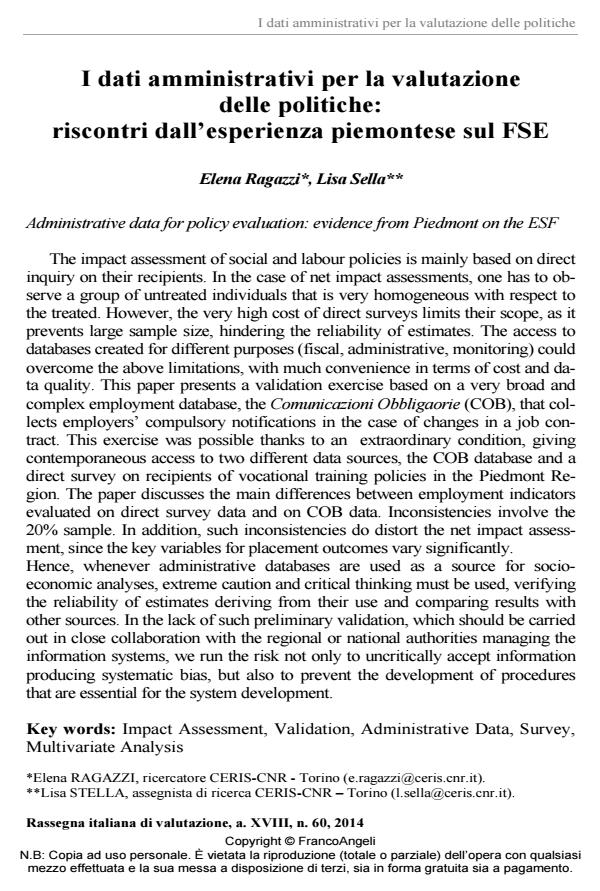I dati amministrativi per la valutazione delle politiche: riscontri dall’esperienza piemontese sul FSE
Titolo Rivista RIV Rassegna Italiana di Valutazione
Autori/Curatori Elena Ragazzi, Lisa Sella
Anno di pubblicazione 2015 Fascicolo 2014/60
Lingua Italiano Numero pagine 24 P. 123-146 Dimensione file 128 KB
DOI 10.3280/RIV2014-060008
Il DOI è il codice a barre della proprietà intellettuale: per saperne di più
clicca qui
Qui sotto puoi vedere in anteprima la prima pagina di questo articolo.
Se questo articolo ti interessa, lo puoi acquistare (e scaricare in formato pdf) seguendo le facili indicazioni per acquistare il download credit. Acquista Download Credits per scaricare questo Articolo in formato PDF

FrancoAngeli è membro della Publishers International Linking Association, Inc (PILA)associazione indipendente e non profit per facilitare (attraverso i servizi tecnologici implementati da CrossRef.org) l’accesso degli studiosi ai contenuti digitali nelle pubblicazioni professionali e scientifiche
The impact assessment of social and labour policies is mainly based on direct inquiry on their recipients. In the case of net impact assessments, one has to observe a group of untreated individuals that is very homogeneous with respect to the treated. However, the very high cost of direct surveys limits their scope, as it prevents large sample size, hindering the reliability of estimates. The access to databases created for different purposes (fiscal, administrative, monitoring) could overcome the above limitations, with much convenience in terms of cost and data quality. This paper presents a validation exercise based on a very broad and complex employment database, the Comunicazioni Obbligaorie (COB), that collects employers’ compulsory notifications in the case of changes in a job contract. This exercise was possible thanks to an extraordinary condition, giving contemporaneous access to two different data sources, the COB database and a direct survey on recipients of vocational training policies in the Piedmont Region. The paper discusses the main differences between employment indicators evaluated on direct survey data and on COB data. Inconsistencies involve the 20% sample. In addition, such inconsistencies do distort the net impact assessment, since the key variables for placement outcomes vary significantly. Hence, whenever administrative databases are used as a source for socioeconomic analyses, extreme caution and critical thinking must be used, verifying the reliability of estimates deriving from their use and comparing results with other sources. In the lack of such preliminary validation, which should be carried out in close collaboration with the regional or national authorities managing the information systems, we run the risk not only to uncritically accept information producing systematic bias, but also to prevent the development of procedures that are essential for the system development.
Parole chiave:Impact Assessment, Validation, Administrative Data, Survey, Multivariate Analysis
- I dati amministrativi per la valutazione delle politiche: riscontri dall'esperienza piemontese sul FSE Elena Ragazzi, Lisa Sella, in RIV Rassegna Italiana di Valutazione 60/2015 pp.123
DOI: 10.3280/RIV2014-060008 - L'interesse del Senato della Repubblica per la pratica valutativa: alcune riflessioni di metodo relativamente agli aiuti per la sicurezza sui luoghi del lavoro Marco Accorinti, Francesco Gagliardi, Elena Ragazzi, Giuliano Salberini, in RIV Rassegna Italiana di Valutazione 70/2019 pp.7
DOI: 10.3280/RIV2018-070002 - Gli incentivi per la salute e sicurezza sul lavoro: riflessione sugli approcci metodologici e sulle criticità dell'analisi valutativa Chiara Colagiacomo, Elena Maria Ragazzi, Lisa Sella, Stefano Signorini, in RIV Rassegna Italiana di Valutazione 71/2019 pp.102
DOI: 10.3280/RIV2018-071006 - I benefici delle valutazioni "ripetute". Evidenze da un'esperienza piemontese Igor Benati, Valentina Lamonica, Elena Ragazzi, Lisa Sella, in RIV Rassegna Italiana di Valutazione 64/2017 pp.7
DOI: 10.3280/RIV2016-064002 - Données administratives et évaluation des politiques régionales Elena Ragazzi, Lisa Sella, in Revue d’Économie Régionale & Urbaine /2018 pp.509
DOI: 10.3917/reru.182.0509
Elena Ragazzi, Lisa Sella, I dati amministrativi per la valutazione delle politiche: riscontri dall’esperienza piemontese sul FSE in "RIV Rassegna Italiana di Valutazione" 60/2014, pp 123-146, DOI: 10.3280/RIV2014-060008